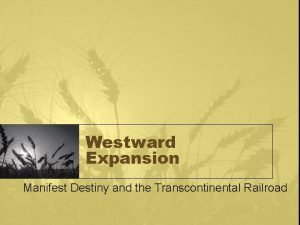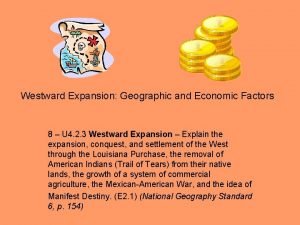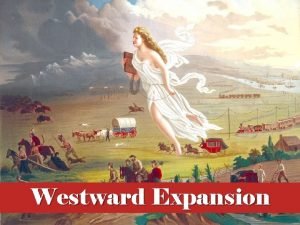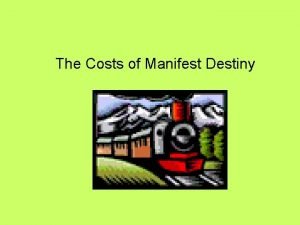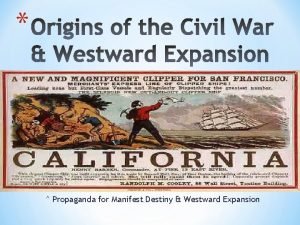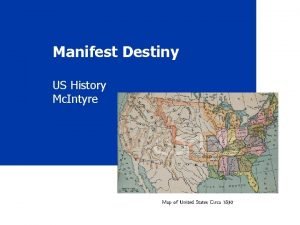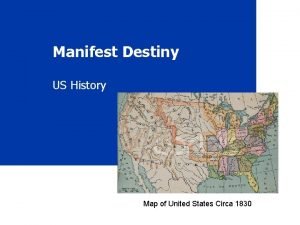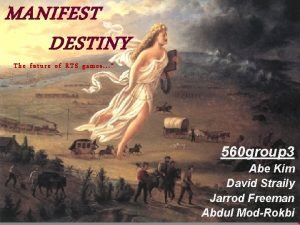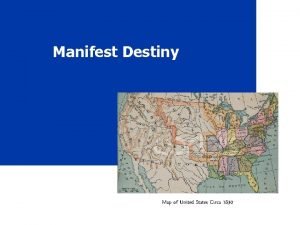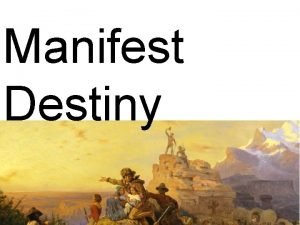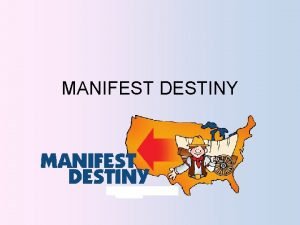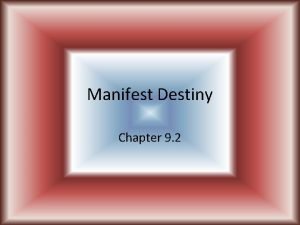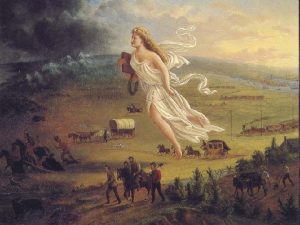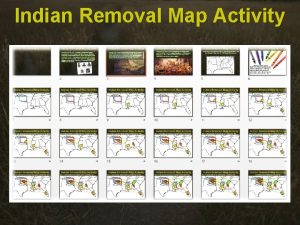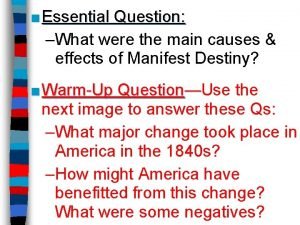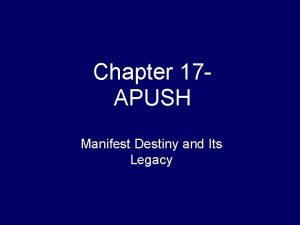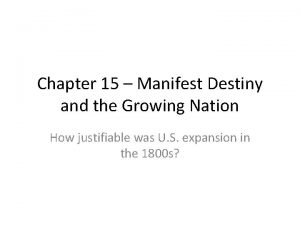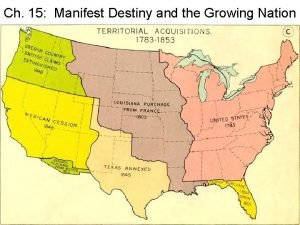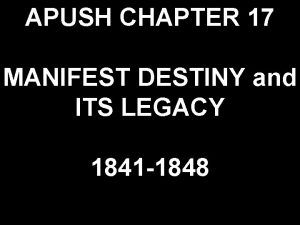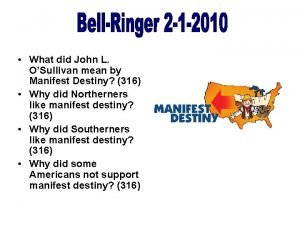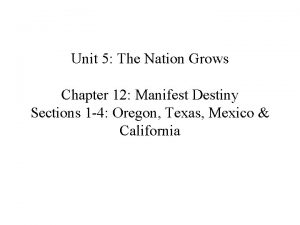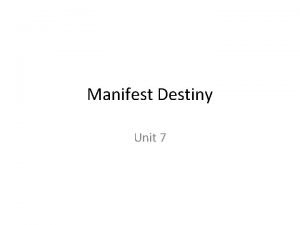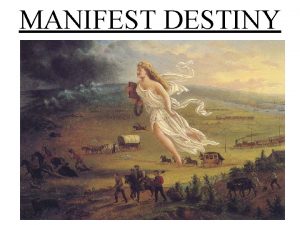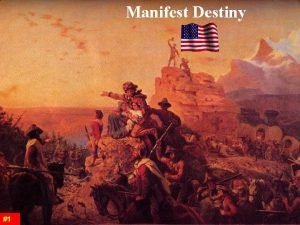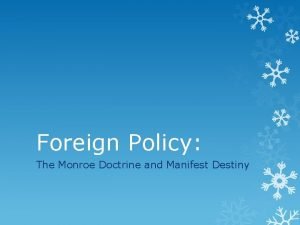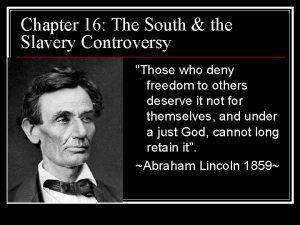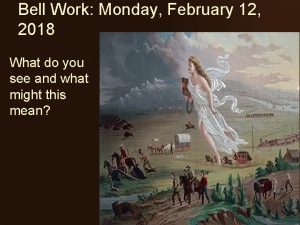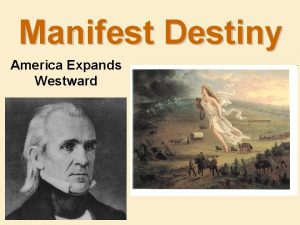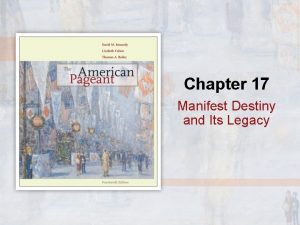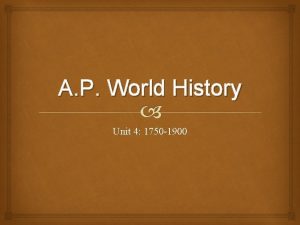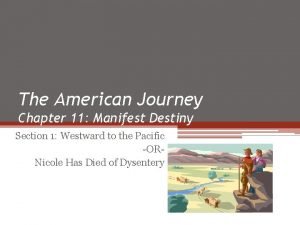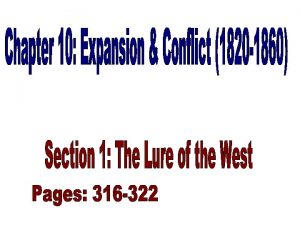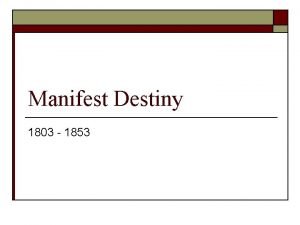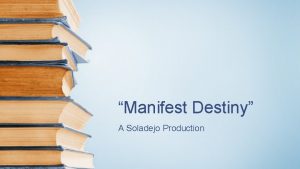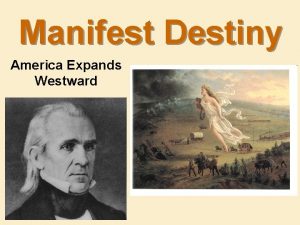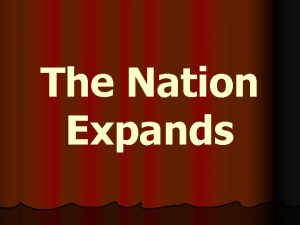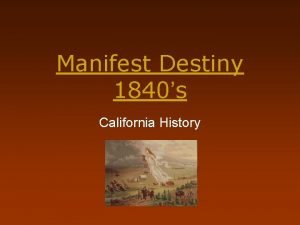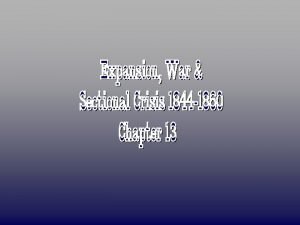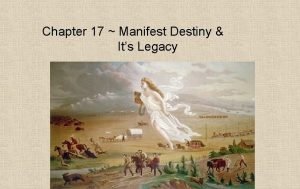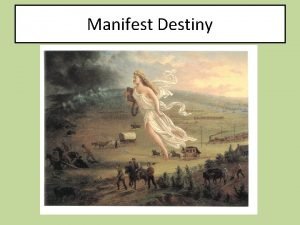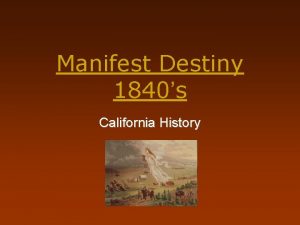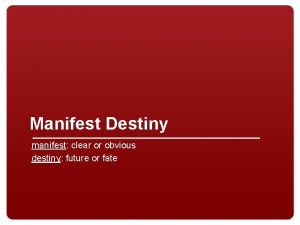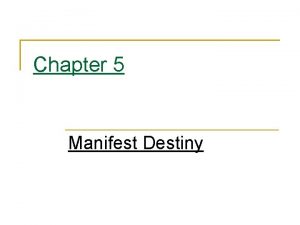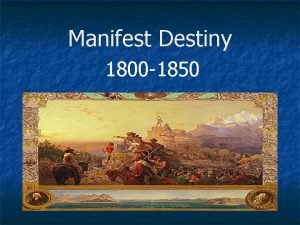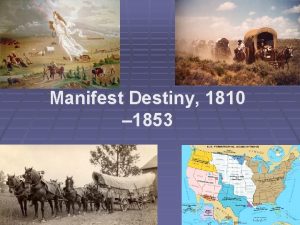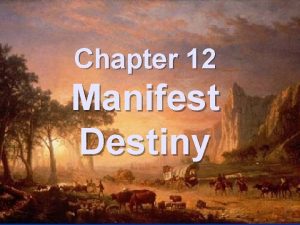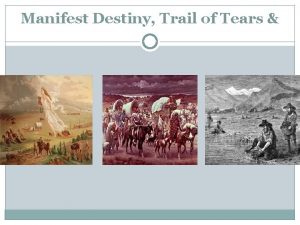Manifest Destiny Term first coined in 1845 Our


































- Slides: 34



Manifest Destiny • Term first coined in 1845 • “Our manifest destiny is to overspread the continent allotted by providence for the free development of our yearly multiplying millions” • The commonly held belief that is was the divine destiny of white Americans to expand west to the Pacific Ocean, convert people to Christianity, and utilize the resources of the land to make America prosper



Oregon Fever • Example of the impacts of Manifest Destiny. • Oregon Territory is jointly settled by the British and Americans, but the British are significantly outnumbered. • Thousands of mostly poor families venture across the continent in covered wagons following the “Oregon Trail”. There are many push factors, but the major pull factor is free, unsettled, and fertile land. • Many parties break off into California or other great plains territories along the way. John Sutter in the Sacramento Valley is one of these early settlers. • By the time James K Polk becomes president in 1844, there are over 10, 000 American settlers in the area, and after threatening war with Great Britain, the US annexes the Oregon Territory in 1846.

Election of 1844 • Annexing Texas and Oregon are major issues in this election. • The US Gov has hesitated to annex Texas, for fear of provoking a war with Mexico. Southern people support it, many northerners do not. • Slave owner and super Andrew Jackson fan James K. Polk runs an aggressive expansionists campaign and wins. • “Fifty-Four Forty or Fight!” is a reference to a Latitude/Longtitude line on the map. Became a rallying cry for Polk supporters during the campaign. • Slavery and Western Migration will be intertwined and have dire consequences as more territory is acquired • Under President Polk, the US map will expand basically take on it’s modern boundaries.



Californios • Several thousand descendants of the Spanish elite residing in California when gold is fund in 1848. • Given huge land grants by the Mexican Government. • Often these people are politicians businessmen, socialites, and military leaders all in one. • Involved in ranching, farming, and the hide and tallow trade • Short but highly “romantic” period. Influential in modern California architecture, place names, and culture today. Mariano Vallejo and his granddaughters at his Rancho Sonoma.




The Situation • As the US annexes Texas in 1845, they send a diplomat named John Slidell to try and buy California and New Mexico for $30 million. • Mexico refuses to see the diplomat, and this is seen as a provocation by Polk. • There is also a border dispute between Texas and Mexico. Is the border the Rio Grande, or the Nueces River?

Mexican American War (1846 -1848) • Polk has American troops take up positions on the Rio Grande, and Mexico feels that it’s territory has now been invaded by a foreign army. • A skirmish breaks out, 17 Americans are killed, and now Polk will claim that “American blood has been shed on American soil” • Congress votes for war and the public is generally enthusiastic about it initially. • As the war goes on, more people will voice objection to it, seeing it as a plot to expand slavery. • Emmerson and Thoreau are outspoken critics of the War. • War is ended by the Treaty of Guadalupe Hidalgo in 1848.



Wilmot Proviso 1846 • Before the war is even over, a bill passed by the House but rejected by the Senate that would ban slavery in all the territory acquired by from Mexico. • Proposed by a guy named David Wilmot from Pennsylvania • “The madmen of the North have, we fear, cast the die and numbered the days of this glorious Union” Richmond Examiner • It does not become law. The Congress is split fully along region lines. • The “Sectional Crisis” that really got energized in 1820 is again very volatile.

Free Soil Movement (1848) • Political party organized that goes in the opposite direction of William Lloyd Garrison. • Free Soil does not preach the evil of slavery or focus on the condition of the slave. • The movement focuses on the threat that slavery poses to free white labor. They call it a threat to Republicanism and the idea of a Jeffersonian society of family yeomen farmers. • How do you compete with someone who doesn’t pay for labor? • This party will organize/fundraise money to send its members into newly acquired territory with the hopes of keeping it free by virtue of occupation.

What are we to do with all of this land we just took from Mexico?

Compromise of 1850 • Admits California to the Union as a Free State • Creates a newer and tougher Fugitive Slave Law • Bans the trading of slaves (but not slavery) in Washington DC • Opens up New Mexico and Utah to Popular Sovereignty. (worst idea ever!) • Address a border dispute with Texas and New Mexico, giving Texas it’s current shape


Uncles Tom’s Cabin (1852) • Famous novel and piece of abolitionists literature by Harriet Beecher Stowe. • Provides a realistic account of fictional slave family. It goes into detail and provides many Americans with their first look at slavery. • It evokes a serious emotional response from readers. • It becomes the most popular book in America at the time and is responsible for bringing in thousands of people into the abolition movement. • Turned into stage plays and silent movies.


Kansas-Nebraska Act (1854) • In order to build a Transcontinental Railroad, the Great Plains need to become official US Territories. Not just stay Indian Land. • Southerners have long rejected making new territories anywhere north of the 36’ 30’ line because slavery is prohibited from existing there. • Pressure to convert the Great Plains into legit territories is mounting. • Southerners will only agree to make more territories if the Missouri Compromise is repealed and the territories are open to Popular Sovereignty. • Two territories are created by this act, Nebraska (which is likely to remain free because of it’s proximity to other Northern states) and Kansas (which borders slave state Missouri and could go either way).


Bleeding Kansas • This shows why Popular Sovereignty is a bad idea. • Free Soilers and Pro-slavery settlers flood into Kansas in an attempt to influence its status as free or slave. • Episodes of violence occur throughout the territory with both sides murdering each other. A miniature Civil War. • John Brown and his sons hack 5 pro-slavery men to death with swords. • A pro-slavery mob sack the abolitionists stronghold town of Lawrence Kansas. • Hundreds of people of both sides die in this conflict.

https: //www. senate. gov/artandhistory/minute/The_Caning_of_Senator_C harles_Sumner. htm

John Brown (1856 and 1859) • Religious Zealot • Radical Abolitionists • Murders pro-slavery men in Kansas. • Tries to incite a slave revolt and take over the military arsenal at Harpers Ferry (just outside DC). • His revolt fails and he is executed. • This event is incredibly divisive and people either see him as a martyr or a crazed murderer.


• https: //www. youtube. com/watch? v=vvek. CTXqj. VM • https: //www. youtube. com/watch? v=EG 4 ukr. Mtd. Ns

Dred Scott (1857) • Must know supreme court case. • Dred Scott is a slave who’s master needs to temporarily move to Illinois (Free State) for a job. The master brings his slave, Dred Scott. • He attempts to bring a lawsuit against his master arguing that by living in a free state, he is a free man. This goes all the way to the Supreme Court. • The majority decision written by Roger Taney says that Dred Scott, as a black man, is not a citizen of the US and therefore may not sue anyone in court. • The ruling also says that slave owners may bring their property into federal territories not yet organized into states (all the land we just got from Mexico). • Taney also declares that the Northwest Ordinance and the Missouri Compromise to be unconstitutional, claiming the federal government cannot restrict slavery in the territories.

• “They had for more than a century before been regarded as beings of an inferior order, and altogether unfit to associate with the white race, either in social or political relations, and so far unfit that they had no rights which the white man was bound to respect” Rodger Taney in the court’s majority decision in Dred Scott v. Sandford

 Term biodiversity coined by
Term biodiversity coined by Transcontinental railroad manifest destiny
Transcontinental railroad manifest destiny Reasons for manifest destiny
Reasons for manifest destiny How did the hudson river school increase westward expansion
How did the hudson river school increase westward expansion Costs of manifest destiny
Costs of manifest destiny California gold rush advertisement
California gold rush advertisement Manifest destiny map
Manifest destiny map Manifest destiny map colored
Manifest destiny map colored Manifest destiny book
Manifest destiny book United states map 1830
United states map 1830 Us land acquisition map
Us land acquisition map This means obvious fate
This means obvious fate Chapter 9 section 2 manifest destiny answer key
Chapter 9 section 2 manifest destiny answer key Manifest destiny book
Manifest destiny book Indian removal act map activity
Indian removal act map activity Reason for manifest destiny
Reason for manifest destiny Destiny poem
Destiny poem Walker tariff apush definition
Walker tariff apush definition Chapter 15 manifest destiny and the growing nation
Chapter 15 manifest destiny and the growing nation Travel in a growing nation answer key
Travel in a growing nation answer key Overland trails apush
Overland trails apush What did john l o'sullivan mean by manifest destiny
What did john l o'sullivan mean by manifest destiny Chapter 12 manifest destiny
Chapter 12 manifest destiny Jimmy fallon gadsden purchase
Jimmy fallon gadsden purchase Manifest destiny effect
Manifest destiny effect What did manifest destiny predict?
What did manifest destiny predict? Manifest destiny
Manifest destiny Manifest destiny
Manifest destiny Monroe doctrine and manifest destiny
Monroe doctrine and manifest destiny Manifest destiny
Manifest destiny How does this painting represent manifest destiny?
How does this painting represent manifest destiny? Define manifest destiny in your own words
Define manifest destiny in your own words Chapter 17 manifest destiny and its legacy
Chapter 17 manifest destiny and its legacy Ethnic enclaves ap world history
Ethnic enclaves ap world history Manifest
Manifest

